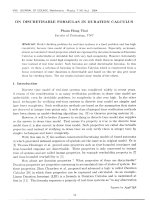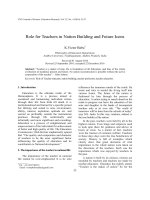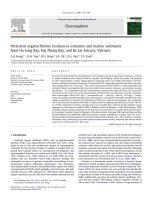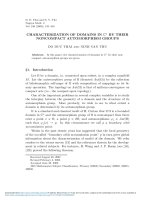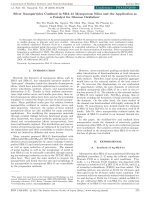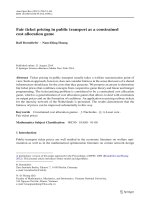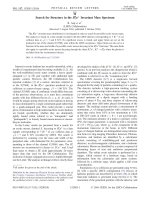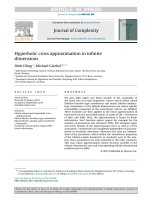DSpace at VNU: Adiabatic polaron transport in La0.9Pb0.1Mn0.3 manganites
Bạn đang xem bản rút gọn của tài liệu. Xem và tải ngay bản đầy đủ của tài liệu tại đây (80.82 KB, 4 trang )
phys. stat. sol. (b) 241, No. 7, 1482 – 1485 (2004) / DOI 10.1002/pssb.200304688
Adiabatic polaron transport in La0.9Pb0.1MnO3 manganites
A. N. Ulyanov1, 2, H. D. Quang1, M. Vasundhara3, C. Nguyen4, and S. C. Yu*, 1
1
2
3
4
Department of Physics, Chungbuk National University, Cheongju, 361-763, Korea
Donetsk Physico-Technical Institute of National Academy of Sciences, 83114 Donetsk, Ukraine
Department of Physics, Indian Institute of Technology, Kharagpur-721 302, India
Center for Material Science, National University of Hanoi, 334 Nguyen Trai, Hanoi, Vietnam
Received 15 November 2003, revised 1 April 2004, accepted 2 April 2004
Published online 18 May 2004
PACS 71.38.+c, 76.30.–v, 77.80.Bh
A study of single-phase La0.9Pb0.1MnO3 compositions is presented. The temperature dependence of the
EPR line intensity and resistivity evidence a spin–lattice interaction in the paramagnetic region near the
Curie point. In the high temperature region a spin–spin interaction is dominant.
© 2004 WILEY-VCH Verlag GmbH & Co. KGaA, Weinheim
1 Introduction Perovskite-like lanthanum manganites attract a renewed interest due to large magnetoresistance (MR) observed near the ferromagnetic ordering temperature [1]. The MR effect was
initially explained by the “double exchange” model [2]. According to Zener, electrons move between
two partially filled 3d shells of Mn3+ and Mn4+ ions with strong on-site Hund’s coupling. The double-exchange model, revealing the connections between the electrical and magnetic subsystems of lanthanum manganites, was complemented by the electron–phonon interaction caused by the Jahn–Teller
splitting of external d-level of manganese [3]. However, the nature of colossal magnetoresistance (CMR)
is not yet clear enough despite a large number of publications on this problem. The difficulties consist
in a close connection between structure, electronic and magnetic properties of perovskite-type manganites. Resonance methods can give useful information about the internal dynamics of these materials,
especially near the Curie temperature, TC, where they show the highest value of the CMR effect. Electron paramagnetic resonance (EPR) has been studied in a variety of lanthanum manganites. Some authors
[4, 5] attributed the temperature dependence of the EPR linewidth to a spin–phonon interaction
(one-phonon relaxation process) and explained it by spin–lattice relaxation of exchange coupled
Mn3+–Mn4+ spin system under the condition of a strong relaxation bottleneck [6, 7]. Other authors
[8 –10] explain the temperature dependence of ESR linewidth by the spin–spin (exchange) interaction.
A careful analysis [11] of both mechanisms, describing the temperature dependence of EPR
linewidth, based on the measurement of the longitudinal electron–spin relaxation time T1 and transverse relaxation time T2 did not clarify this question. The temperature dependence of the ESR line intensity I(T) is also not so clear. According to Refs. [1, 12] I(T) decreased exponentially with increasing
temperature and was inversely proportional [5] to temperature. To clarify the situation we carried out the
EPR and resistivity measurements of La0.9Pb0.1MnO3 manganite to study the nature of interaction near
the Curie point.
2 Sample preparation and experimental technique The La0.9Pb0.1MnO3 (LPMO) composition was
prepared by ceramic technology and were single phase according to X-ray diffraction analysis. The EPR
study was performed at 9.2 GHz with the Jeol JES-TE300 ESR Spectrometer. In the paramagnetic region
*
Corresponding author: e-mail: , Phone: +82-43-271-8146, Fax: +82-43-275-6416
© 2004 WILEY-VCH Verlag GmbH & Co. KGaA, Weinheim
phys. stat. sol. (b) 241, No. 7, (2004) / www.pss-b.com
1483
the EPR spectra were single Lorentzian lines with g ≈ 2 and that value was temperature independent.
Resistance measurements were performed using the four-probe technique. Magnetization was measured
using a vibrating sample magnetometer.
3 Results and discussion The Curie temperature of the sample was determined by the extrapolation of
magnetization to zero value in its temperature dependence and equals to 230 K.
Figure 1 shows the temperature dependence of resistivity, ρ. It can be fitted well using the nearestneighbor hopping model of small polarons [13]
ρ (T ) ∝ T exp ( Eσ /kBT ) ,
(1)
with an activation energy Eσ = 0.16 eV (kB is the Boltzmann constant).
The EPR line intensity, I(T), was determined by double integration of the experimental derivative
absorption curve. The temperature dependences of EPR line intensity I(T) and inverse line intensity,
1/I(T), for LPMO composition are shown in Fig. 1. Let us consider some expressions, describing the
CMR material parameters, to fit the I(T) dependence. The EPR linewidth obeys
∆H ∝ 1/(T χ dc ) ,
(2)
according to the spin–spin interaction model [8] (χdc is the static susceptibility). At the same time [7],
∆H ∝ σ (T )
(3)
and, according to the adiabatic polaron hopping model [13] (see Eq. (1)), σ (T) ∝ (1/T) exp (–Eσ /kBT)
(σ is the conductivity). Taking into account also that EPR line intensity [8]
I (T ) ∝ χ dc ,
(4)
one can find
I (T ) ∝ I 0 exp ( Ea /kBT ) .
(5)
8
2.0
La0.9Pb0.1MnO3
1.8
1.6
1.4
7
6
ρ(T)
5
1.2
4
1.0
0.8
3
I(T)
0.6
2
0.4
0.2
0.0
1
Θ
0
250 300 350 400 450 500 550
1/I(T) (arb. units)
I(T) (arb. units), resistivity (Ω*cm)
Equation (5) gives a good fit for the I (T) data obtained for the La0.9Pb0.1MnO3 compositions. It permitted to deduce a value of the activation energy Ea (= 0.11 eV). The value of the activation energy obtained
from the resistivity (Eσ) and EPR (Ea) measurements is consistent with the ones reported in Ref. [8, 12].
The less value of activation energy deduced from the I (T) dependence than that from the ρ (T) dependence can be caused by the decrease of activation energy in magnetic field, where the EPR resonance was
observed. By extrapolating the linear (high temperature part) of the 1/I(T) dependence to zero value it is
Fig. 1 Resistivity vs temperature (solid triangular) and
fitting curve (solid) according to Eq. (1) and temperature
dependencies of EPR line intensity, I (T) (closed
squares); inverse intensity 1 /I (T) (open cycles); and
fitting curves according to exponential decay (Eq. (5))
(solid line), and for inverse intensity (dot line).
Temperature (K)
© 2004 WILEY-VCH Verlag GmbH & Co. KGaA, Weinheim
1484
A. N. Ulyanov et al.: Adiabatic polaron transport in La0.9Pb0.1MnO3
possible to obtain the Curie–Weiss temperature, Θ (≈278 K). As one can see from Fig. 1 the Curie–
Weiss law, I (T) ∝ 1/(T–Θ), does not describe properly the temperature dependence of the EPR line
intensity in a wide temperature range around TC. The exponential decay and Curie–Weiss law coincide at
high temperatures, indicating a decrease of spin–lattice interaction and the dominance of the spin–spin
one.
The deviation of the temperature dependence of the EPR line intensity from the Curie–Weiss law near
TC was explained by the formation of spin clusters, when TC is approached from above [12, 14]. The
authors of works [8, 9] explained the deviation of the static susceptibility from the Curie–Weiss law in
the frame of the constant coupling approximation model. At the same time, polaron formation across the
ferromagnetic–paramagnetic phase transition was observed, which was reported by the study on the
La1–xAxMnO3 (A = Ca, Pb) perovskite system by the extended X-ray absorption fine structure (EXAFS)
spectroscopy [15]. It seems, that deviation of experimental I (T) data from Curie–Weiss law observed can
be caused by the spin–lattice interaction in the vicinity of TC and are in agreement also with the prediction of the adiabatic polaron hopping model [13]. From this point of view, the exponential dependence of
the EPR line intensity on temperature reflects the formation of polarons near the Curie point. Those polarons are centered by the Mn3+ and Mn4+ ions and mediated by the double (through the O2– ion) activated
hopping of the electrons.
Let us comment on validity of Eq. (5). Assumptions (1) and (3) were made to deduce it. It is known
[13] that the resistivity in the paramagnetic region can be described by the nearest-neighbor hopping of
small (Holstein) polarons (Eq. (1)). Mott’s variable-range hopping expression σ(T) ∝ exp (–T0 /T)1/4 is
appropriate to describe the experimental data if the carriers are localized by the random potential fluctuations (T0 is related to the localized length). The temperature dependence (1) in mixed-valence manganites
was observed, except the present work, for examples, in works [16 –18]. And, about the validity of
Eq. (3). Except in [7] where the authors observed the proportionality between EPR linewidth, ∆H, and
conductivity σ(T) ∝ (1/T) exp (–Eσ /kBT) taken from [16], we know the only works [8, 9] where the EPR
linewidth in La0.7Ca0.3MnO3 sample was measured in wide temperature range (up to 1000 K). We replotted that data in the scale ln (∆H–T) on 1/T (see insert in Fig. 2) and, as one can see, the obtained dependence is very close to the linear one that confirms the validity of expression (3) again. So, it can be concluded that the Eqs. (1) and (3) as well as the deduced Eq. (5) are valid under the predicted determined
conditions.
Acknowledgements The Research at Chungbuk National University was supported by the Korea Science and
Engineering Foundation through the Research Center for Advanced Magnetic Materials at Chungnam National
University. A. N. Ulyanov was supported by Korea Institute of Science and Technology Evaluation and Planning
(KISTEP) during this work.
∆H*T (arb. units)
14
[8,12]
13
12
Fig. 2 Natural logarithm of the EPR linewidth ∆H – T dependence
on reciprocal temperature from Ref. [8, 12]. The solid line is a
linear fit for the experimental data.
11
0.001
0.002
0.003
1/T (1/K)
© 2004 WILEY-VCH Verlag GmbH & Co. KGaA, Weinheim
phys. stat. sol. (b) 241, No. 7, (2004) / www.pss-b.com
1485
References
[1]
[2]
[3]
[4]
[5]
[6]
[7]
[8]
[9]
[10]
[11]
[12]
[13]
[14]
[15]
[16]
[17]
[18]
J. M. D. Coey, M. Viret, and S. von Molnar, Adv. Phys. 48, 167 (1999).
N. Zener, Phys. Rev. 82, 403 (1951).
A. J. Millis, P. B. Littlewood, and B. I. Shraiman, Phys. Rev. Lett. 74, 5144 (1995).
C. Rettori, D. Rao, J. Singley, D. Kidwell, S. B. Oseroff, M. T. Causa, J. J. Neumeier, K. J. McClellan, S.-W.
Cheong, and S. Schultz, Phys. Rev. B 55, 3083 (1997).
S. E. Lofland, P. Kim, P. Dahiroc, S. M. Bhabat, S. D. Tyagi, S. G. Karabashev, D. A. Shulyatev, A. A. Arsenov, and Y. Mukovskii, Phys. Lett. A 233, 476 (1997).
A. Shengelaya, Guo-meng Zhao, H. Keller, and K. A. Muller, Phys. Rev. Lett. 77, 5296 (1996).
A. Shengelaya, Guo-meng Zhao, H. Keller, and K. A. Muller, Phys. Rev. B 61, 5888 (2000).
M. T. Causa, M. Tovar, A. Caneiro, F. Prado, G. Ibañez, C. A. Ramos, A. Butera, B. Alascio, X. Obradors,
S. Piñol, F. Rivadulla, C. Vázques-Vázques, M. A. López-Quintela, J. Rivas, Y. Tokura, and S. B. Oseroff,
Phys. Rev. B 58, 3233 (1998).
M. Tovar, M. T. Causa, G. Ibañez, C. A. Ramos, A. Butera, F. Rivadulla, B. Alascio, S. B. Oseroff, S.-W.
Cheong, X. Obradors, and S. Piñol, J. Appl. Phys. 83, 7201 (1998).
D. L. Huber, G. Alejandro, A. Caneiro, M. T. Causa, F. Prado, M. Tovar, and S. B. Oseroff, Phys. Rev. B 60,
1215 (1999).
V. A. Atsarkin, V. V. Demidov, G. A. Vasneva, and K. Conder, Phys. Rev. B 63, 092405 (2001).
S. B. Oseroff, M. Torikachvili, J. Singley, S. Ali, S.-W. Cheong, and S. Schultz, Phys. Rev. B 53, 6521 (1996).
D. Emin and T. Holstein, Ann. Phys. 53, 439 (1969).
A. I. Shames, E. Rosenberg, W. H. McCarroll, M. Greenblatt, and G. Gorodetsky, Phys. Rev. B 64, 172401
(2001).
C. H. Booth, F. Bridges, G. J. Snyder, and T. H. Geballe, Phys. Rev. B 54, R15606 (1996).
D. C. Worledge, G. Jeffrey Snyder, M. R. Beasley, T. H. Geballe, R. Hiskes, and S. DiCarolis, J. Appl. Phys.
80, 5158 (1996).
J. M. D. Coey, M. Viret, L. Ranno, and K. Ounadjela, Phys. Rev. Lett. 75, 3910 (1995).
M. Ziese and C. Srinitiwarawong, Phys. Rev. B 58, 11519 (1998).
© 2004 WILEY-VCH Verlag GmbH & Co. KGaA, Weinheim

